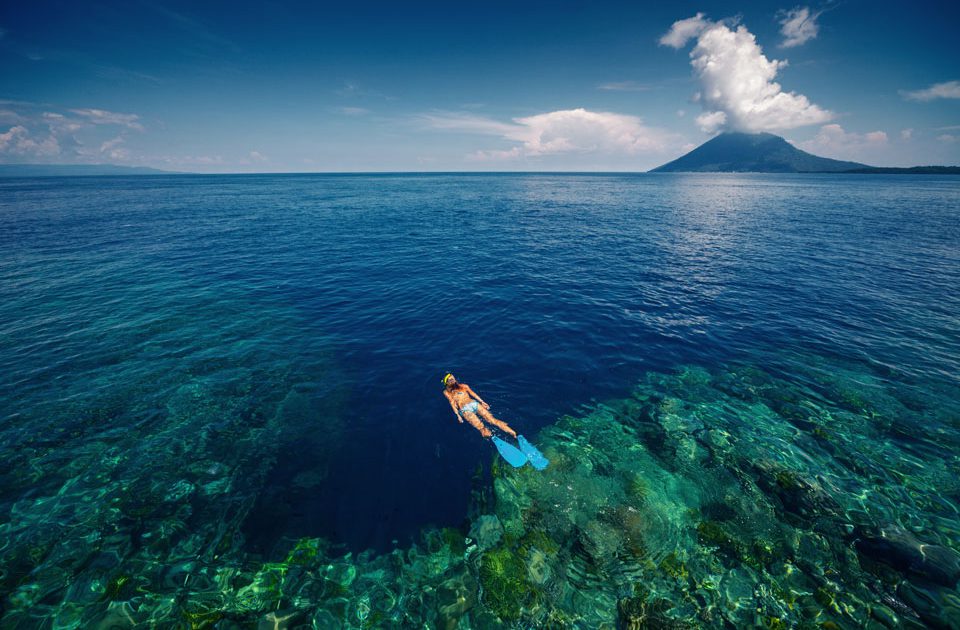 |
| Bunaken Marine Park, North Sulawesi (Pics: cruisingindonesia.com) |
NICETRAVELERS.CYOU - Indonesia, an archipelago of over 17,000 islands, is a paradise for adventure enthusiasts. With its diverse landscapes, rich marine life, and challenging terrains, Indonesia offers some of the best spots for hiking and snorkeling. Whether you are a seasoned adventurer or a beginner looking for a thrilling experience, Indonesia has something to offer for everyone. Let’s explore some of the top hiking and snorkeling destinations in this beautiful country.
5 Best Hiking Spots in Indonesia
1. Mount Rinjani, Lombok
Mount Rinjani, the second-highest volcano in Indonesia, is a favorite among hikers. Standing tall at 3,726 meters, this active volcano offers a challenging trek with rewarding views. The hike typically takes two to three days, taking you through dense forests, savannahs, and up steep slopes.
The highlight of the trek is reaching the crater rim, where you can see the stunning Segara Anak Lake and the small volcanic cone within it. Camping by the crater lake under a starry sky is an unforgettable experience.
2. Mount Bromo, East Java
Mount Bromo, part of the Bromo Tengger Semeru National Park, is one of the most iconic and accessible volcanoes in Indonesia. Although not a particularly strenuous hike, the surreal landscapes make it a must-visit.
The best way to experience Mount Bromo is by catching the sunrise from the viewpoint at Mount Penanjakan. The sight of the sun rising over the caldera, with Mount Bromo’s smoldering crater and Mount Semeru in the background, is breathtaking.
3. Mount Semeru, East Java
For those seeking a more challenging hike, Mount Semeru, the highest peak in Java at 3,676 meters, is an excellent choice. The trek to the summit is demanding and usually takes two to three days.
Hikers are rewarded with stunning views of the surrounding landscapes and the satisfaction of reaching the top of one of Indonesia’s most majestic volcanoes. The final ascent, starting in the early hours to reach the summit for sunrise, is particularly exhilarating.
4. Mount Kelimutu, Flores
Mount Kelimutu, located in central Flores, is famous for its three colorful crater lakes. Each lake has a different hue, which changes over time due to chemical reactions. The hike to the summit is relatively short and accessible, making it a great option for those who prefer a less strenuous trek.
The best time to visit is at sunrise when the colors of the lakes are most vibrant and the surrounding landscapes are bathed in a golden light.
5. Mount Agung, Bali
Mount Agung, the highest peak in Bali, offers a challenging yet rewarding hike. Standing at 3,031 meters, this active volcano is considered sacred by the Balinese people. The trek typically starts in the early hours of the morning to reach the summit by sunrise.
The climb is steep and requires a good level of fitness, but the panoramic views of Bali and the surrounding islands from the top are well worth the effort.
5 Best Snorkeling Spots in Indonesia
1. Raja Ampat, West Papua
Raja Ampat is renowned as one of the best snorkeling destinations in the world. This archipelago boasts crystal-clear waters, vibrant coral reefs, and an incredible diversity of marine life. Snorkelers can expect to see a wide range of species, including manta rays, sharks, turtles, and countless colorful fish.
The islands themselves are stunning, with lush greenery and pristine beaches, making Raja Ampat a true paradise for nature lovers.
2. Bunaken Marine Park, North Sulawesi
Bunaken Marine Park, located off the coast of North Sulawesi, is another top snorkeling spot in Indonesia. The park is known for its rich biodiversity, with over 390 species of coral and a variety of marine life.
The clear waters and steep drop-offs make it an ideal location for snorkeling. Popular sites like Fukui Point and Lekuan offer stunning underwater landscapes and a chance to see larger species like reef sharks and turtles.
3. Komodo National Park, East Nusa Tenggara
Komodo National Park is famous for its resident Komodo dragons, but it also offers some of the best snorkeling in Indonesia. The park’s waters are teeming with marine life, including manta rays, sharks, and vibrant coral reefs.
Sites like Pink Beach and Manta Point are particularly popular among snorkelers. The combination of unique wildlife on land and stunning underwater scenery makes Komodo National Park a must-visit destination.
4. Gili Islands, Lombok
The Gili Islands, located off the northwest coast of Lombok, are a popular destination for snorkeling and diving. The three islands—Gili Trawangan, Gili Meno, and Gili Air—offer clear waters, abundant marine life, and beautiful coral reefs.
Turtle Point on Gili Trawangan and the underwater statues on Gili Meno are among the highlights. The relaxed island vibe and stunning beaches make the Gili Islands a great place to unwind and explore the underwater world.
5. Wakatobi National Park, Southeast Sulawesi
Wakatobi National Park is a lesser-known gem that offers world-class snorkeling opportunities. The park is home to some of the most pristine coral reefs in Indonesia, with over 850 species of coral and a rich diversity of marine life.
The clear waters and healthy reefs provide excellent visibility and vibrant underwater landscapes. Snorkeling sites like Tomia and Hoga Island are particularly popular for their stunning coral formations and abundant marine life.
Conclusion
Indonesia is a treasure trove of adventure, offering some of the best hiking and snorkeling experiences in the world. From the challenging climbs of Mount Rinjani and Mount Semeru to the vibrant underwater worlds of Raja Ampat and Bunaken, there is something for every adventure enthusiast.
These destinations not only offer thrilling experiences but also provide a deeper appreciation of Indonesia’s natural beauty and rich biodiversity. So, pack your gear, and embark on an unforgettable adventure in the heart of Southeast Asia.


.jpeg)



0 Comments